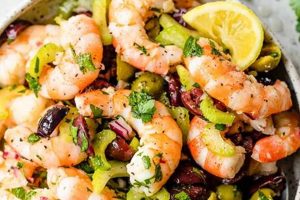This dish combines the classic elements of potato salad cooked potatoes, often combined with other vegetables like celery and onion with the creamy, tangy flavor profile of ranch dressing. A typical preparation involves boiling potatoes until tender, then combining them with the chosen vegetables and a generous amount of ranch dressing. Variations may include the addition of hard-boiled eggs, bacon, or other seasonings.
The appeal lies in its simplicity and satisfying flavor combination. Ranch dressing, with its herbaceous and slightly acidic notes, offers a different take on traditional mayonnaise-based potato salads. This alternative provides a lighter, brighter taste that can be particularly appealing during warmer months. Furthermore, the relative ease of preparation makes it a popular choice for picnics, potlucks, and casual gatherings. This contemporary variation reflects evolving culinary preferences and the ongoing search for convenient yet flavorful dishes.
The following sections will explore various aspects of preparing this dish, including selecting the right potatoes, customizing ingredient combinations, and achieving optimal flavor balance.
Tips for a Perfect Potato Salad with Ranch Dressing
Achieving a well-balanced and flavorful potato salad requires attention to detail. These tips offer guidance for optimal results.
Tip 1: Potato Selection Matters: Opt for waxy potatoes like red or Yukon Gold. These varieties hold their shape well after boiling and contribute a creamy texture.
Tip 2: Uniformity is Key: Dice potatoes into consistent sizes to ensure even cooking and a pleasing presentation.
Tip 3: Avoid Overcooking: Cook potatoes until tender but not mushy. They should be easily pierced with a fork but still hold their shape.
Tip 4: Cool Before Dressing: Allow the potatoes to cool completely before adding the ranch dressing. This prevents the dressing from thinning and ensures a creamier salad.
Tip 5: Customize the Ranch: Enhance the flavor of store-bought ranch dressing by adding fresh herbs like dill, chives, or parsley.
Tip 6: Complementary Ingredients: Incorporate other vegetables for added flavor and texture. Celery, red onion, and bell peppers are popular choices.
Tip 7: Seasoning is Essential: Don’t neglect seasoning. Salt, black pepper, and a touch of garlic powder can elevate the overall flavor profile.
Tip 8: Chill Before Serving: Allow the potato salad to chill thoroughly in the refrigerator before serving. This allows the flavors to meld and enhances the creamy texture.
By following these tips, one can create a potato salad that is both flavorful and visually appealing. Careful attention to ingredient selection, cooking techniques, and seasoning creates a dish that is sure to impress.
By considering these elements, a delicious and satisfying potato salad experience is readily achievable.
1. Potato Variety
Potato variety significantly influences the final texture and flavor profile of potato salad made with ranch dressing. Different potato varieties possess varying starch content and moisture levels, affecting their behavior when boiled. High-starch potatoes, such as Russets, tend to become fluffy and absorbent when cooked, making them less suitable for potato salad as they may absorb excessive dressing and become mushy. Conversely, low-starch, waxy potatoes like red potatoes or Yukon Golds hold their shape better after cooking, resulting in a firmer, more desirable texture for potato salad. This textural integrity allows the potatoes to maintain their individual form within the salad, contributing to a more pleasing overall consistency. For instance, using red potatoes in a ranch-based potato salad allows the creamy dressing to coat the potatoes without overwhelming their texture, creating a balanced and enjoyable culinary experience.
The choice of potato also subtly impacts the flavor. While the dominant flavor in a ranch potato salad comes from the dressing itself, the potato acts as a foundation, subtly influencing the overall taste. Waxy potatoes, with their slightly sweet and buttery flavor, complement the herbaceous and tangy notes of ranch dressing exceptionally well. This synergy creates a more nuanced flavor profile compared to using a neutral-tasting high-starch potato. Consider the difference between a Yukon Gold potato salad and a Russet potato salad dressed with ranch: the former offers a richer, subtly sweet counterpoint to the ranch, while the latter might taste blander, with the ranch flavor dominating.
Selecting the appropriate potato variety is therefore crucial for achieving the desired texture and optimizing flavor balance in a ranch potato salad. Prioritizing waxy potatoes ensures a firm, non-mushy texture that complements the creamy dressing. This understanding allows for a more informed approach to recipe development and ensures a consistently satisfying culinary outcome. Ignoring the nuances of potato varieties can lead to a less enjoyable dish, highlighting the practical significance of this knowledge in culinary practice.
2. Ranch Dressing
Ranch dressing plays a pivotal role in this particular potato salad variation, distinguishing it from traditional mayonnaise-based versions. Its influence extends beyond simply acting as a dressing; it fundamentally shapes the flavor profile and overall culinary experience. Understanding the components and characteristics of ranch dressing is crucial for appreciating its contribution to this dish.
- Flavor Profile
The characteristic flavor of ranch dressing, derived from a blend of buttermilk, herbs, and spices, provides a tangy, herbaceous counterpoint to the starchy potatoes. This complexity contrasts with the richness of mayonnaise, offering a lighter, brighter flavor dimension. The interplay between the creamy base and the fresh herbs creates a nuanced taste experience that complements the other ingredients in the salad.
- Texture and Consistency
Ranch dressing’s creamy consistency coats the potatoes effectively, ensuring even distribution of flavor. Its viscosity is typically lighter than mayonnaise, contributing to a less dense, more refreshing salad. This lighter texture makes it particularly suitable for warmer weather or as a lighter side dish.
- Ingredient Compatibility
Ranch dressing harmonizes well with common potato salad additions such as celery, onion, and hard-boiled eggs. The herbaceous notes within the dressing enhance these ingredients, creating a cohesive flavor profile. For example, the sharpness of raw onion is tempered by the creaminess of the ranch, while the subtle flavor of hard-boiled eggs is complemented by the herbs and spices.
- Versatility and Adaptability
The versatility of ranch dressing allows for customization. Fresh herbs, spices, or even a touch of citrus zest can be added to tailor the flavor profile to individual preferences. This adaptability makes it a suitable base for a wide range of potato salad variations, catering to diverse palates.
The interplay of these facets establishes ranch dressing as a defining component of this potato salad variation. Its distinct flavor profile, texture, and adaptability contribute to a unique culinary experience that sets it apart from traditional potato salads. The careful consideration of these characteristics is essential for achieving a well-balanced and flavorful dish.
3. Ingredient Balance
Ingredient balance is paramount in a successful potato salad featuring ranch dressing. The interplay of flavors and textures contributes significantly to the overall enjoyment of the dish. Careful consideration of ingredient proportions ensures that no single element overpowers the others, resulting in a harmonious and flavorful experience. This section will explore key facets of ingredient balance within this specific culinary context.
- Potato-to-Dressing Ratio
The ratio of potatoes to ranch dressing directly impacts the salad’s consistency and flavor. Too much dressing can result in a soggy, overly rich salad, while too little can leave the potatoes dry and under-seasoned. Achieving the right balance ensures that the potatoes are adequately coated without being overwhelmed by the dressing. A typical guideline is to use enough dressing to coat the potatoes thoroughly while still allowing their individual textures to remain distinct.
- Complementary Ingredients
Incorporating complementary ingredients enhances the flavor profile and textural complexity of the salad. Common additions include celery, onion, and hard-boiled eggs. However, the quantity of these additions must be carefully considered. Overabundance of any single ingredient can disrupt the balance, masking the flavor of the potatoes and ranch dressing. For instance, excessive celery can create an overpowering celery flavor, detracting from the overall balance of the dish. Moderation is essential to ensure that these additions enhance, rather than dominate, the primary flavors.
- Seasoning
Proper seasoning is crucial for enhancing the overall flavor profile. Salt and pepper are fundamental, but other seasonings, such as garlic powder, onion powder, or paprika, can add depth and complexity. However, over-seasoning can easily overwhelm the delicate balance of flavors. A judicious approach to seasoning allows the inherent flavors of the potatoes, ranch dressing, and other ingredients to shine through while adding subtle nuances that elevate the overall taste experience.
- Acidity
A touch of acidity can brighten the flavors of the salad and provide a refreshing counterpoint to the richness of the ranch dressing. A splash of vinegar or a squeeze of lemon juice can achieve this balance. However, excessive acidity can make the salad taste overly tart. Careful adjustment of the acidic element ensures that it enhances the flavor profile without creating an unpleasant imbalance.
Achieving optimal ingredient balance in a ranch potato salad involves careful consideration of these interconnected factors. The interplay of potato-to-dressing ratio, complementary ingredients, seasoning, and acidity ultimately determines the final flavor and textural experience. A well-balanced salad allows each component to contribute to the overall harmony of the dish, resulting in a satisfying and flavorful culinary creation. Understanding these nuances allows for informed adjustments based on personal preferences and desired outcomes.
4. Preparation Method
Preparation methods significantly influence the final quality and flavor profile of potato salad made with ranch dressing. Understanding and executing each step correctly ensures a successful outcome. From potato selection and cooking techniques to ingredient incorporation and chilling, each stage contributes to the overall culinary experience.
- Potato Preparation
Selecting and preparing the potatoes correctly is crucial. Choosing waxy potatoes, such as red or Yukon Gold, is recommended due to their ability to hold their shape after cooking. Uniform dicing ensures even cooking. Overcooking should be avoided as it leads to a mushy texture. Potatoes should be cooked until tender but still firm, easily pierced with a fork but not falling apart. This careful preparation lays the foundation for a well-textured and flavorful salad.
- Cooling and Combining Ingredients
Allowing the cooked potatoes to cool completely before adding the ranch dressing is essential. Adding dressing to warm potatoes can cause it to thin and compromise the salad’s creaminess. Once cooled, the potatoes should be gently combined with the ranch dressing and other chosen ingredients. Careful mixing prevents the potatoes from breaking down while ensuring even distribution of the dressing and other components. This step directly impacts the texture and flavor distribution within the final product.
- Ingredient Incorporation
The order and manner in which additional ingredients are incorporated affect the final flavor and texture. Adding more delicate ingredients, such as fresh herbs, towards the end prevents them from becoming bruised or wilted. Incorporating ingredients in stages allows for better control over flavor distribution and prevents overmixing. For instance, adding chopped celery and onion after the potatoes have been coated in ranch dressing helps maintain their crisp texture and distinct flavor contributions.
- Chilling and Serving
Chilling the prepared salad allows the flavors to meld and enhances the overall experience. A minimum chilling time of one hour is recommended, allowing the potatoes to absorb the flavors of the ranch dressing and other ingredients. Serving the salad chilled enhances its refreshing qualities, particularly during warmer months. This final step contributes significantly to the overall enjoyment and flavor development of the dish.
Each stage of the preparation method, from initial potato selection to final chilling, contributes to the overall quality of the potato salad. Careful execution of these steps ensures a well-balanced, flavorful, and texturally pleasing dish. Neglecting any of these elements can compromise the final result, highlighting the importance of a methodical and attentive approach to preparation.
5. Chilling Time
Chilling time plays a crucial role in the final quality and flavor development of potato salad made with ranch dressing. This seemingly passive step significantly impacts both the textural and gustatory aspects of the dish. Allowing sufficient chilling time fosters flavor melding and enhances the creamy consistency characteristic of a well-made potato salad. The process facilitates the absorption of the ranch dressing into the potatoes, resulting in a more uniform flavor distribution. Furthermore, chilling firms the potatoes, contributing to a more desirable texture.
The impact of chilling time becomes particularly evident when comparing a freshly made potato salad to one that has been chilled for several hours. A freshly made salad, while palatable, often lacks the depth of flavor and cohesive texture that develops during chilling. The ranch dressing may taste somewhat separate from the potatoes, and the overall impression can be bland. Conversely, a chilled salad exhibits a more integrated flavor profile. The ranch dressing permeates the potatoes, creating a harmonious blend of flavors. The potatoes themselves develop a firmer, more satisfying texture. For example, a potato salad chilled overnight allows ample time for the potatoes to absorb the ranch’s herbaceous notes, resulting in a more pronounced and enjoyable flavor.
Understanding the significance of chilling time allows for better planning and execution in preparing this dish. While time constraints might tempt one to shorten or eliminate this step, doing so compromises the overall quality. Incorporating adequate chilling time, ideally a minimum of two hours, into the preparation process ensures a more flavorful and texturally pleasing result. This attention to detail elevates the dish from simply palatable to truly enjoyable, demonstrating the practical significance of understanding the role of chilling time in achieving optimal culinary results.
Frequently Asked Questions
This section addresses common inquiries regarding potato salad prepared with ranch dressing, offering concise and informative responses.
Question 1: What type of potato is best suited for this recipe?
Waxy potatoes, such as red potatoes or Yukon Golds, are recommended. These varieties hold their shape well after cooking and provide a desirable texture in potato salad.
Question 2: Can the ranch dressing be made from scratch?
While store-bought ranch dressing offers convenience, homemade versions allow for customization and control over ingredients. Numerous recipes are readily available online and in cookbooks.
Question 3: How long should the potato salad be chilled?
A minimum of two hours is recommended to allow the flavors to meld. Chilling overnight enhances flavor development and improves texture.
Question 4: What other ingredients can be added to enhance the flavor profile?
Common additions include chopped celery, red onion, hard-boiled eggs, bacon bits, and fresh herbs such as dill or chives. Ingredient selection depends on individual preferences.
Question 5: How can one prevent the potato salad from becoming too watery?
Ensuring the potatoes are thoroughly cooled before adding the ranch dressing helps prevent excess moisture. Additionally, avoiding overcooking the potatoes prevents them from becoming overly absorbent.
Question 6: Can this potato salad be made ahead of time for a large gathering?
This dish is well-suited for advance preparation. It can be made a day or two in advance and stored, tightly covered, in the refrigerator. This makes it a convenient option for potlucks and picnics.
Understanding these common points of inquiry facilitates successful preparation and enjoyment of this dish. Careful consideration of ingredient selection, preparation techniques, and chilling time ensures optimal flavor and texture.
The following section will provide a sample recipe for preparing potato salad with ranch dressing.
Conclusion
Exploration of this specific potato salad variation reveals the critical interplay of ingredients, techniques, and timing. Careful potato selection, proper cooking methods, and balanced ingredient incorporation contribute significantly to the final product. The choice of ranch dressing, whether store-bought or homemade, further shapes the flavor profile. Adequate chilling time allows flavors to meld, enhancing the overall culinary experience. This dish demonstrates how seemingly simple preparations can yield complex and satisfying results through attention to detail.
Culinary exploration often involves revisiting classic dishes with innovative twists. This variation on traditional potato salad exemplifies such innovation, offering a fresh perspective on a familiar favorite. The continued evolution of culinary traditions ensures a vibrant and dynamic food landscape, inviting further experimentation and appreciation for the nuances of flavor and technique. This exploration serves as a reminder of the potential for culinary creativity within even the most established recipes.






